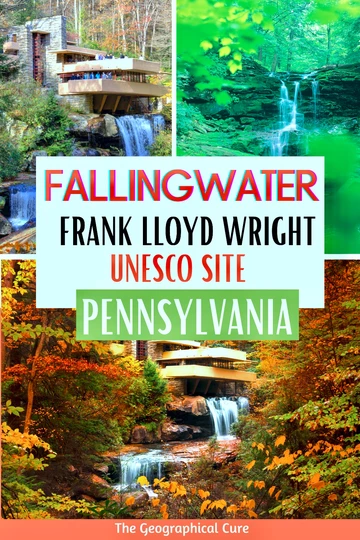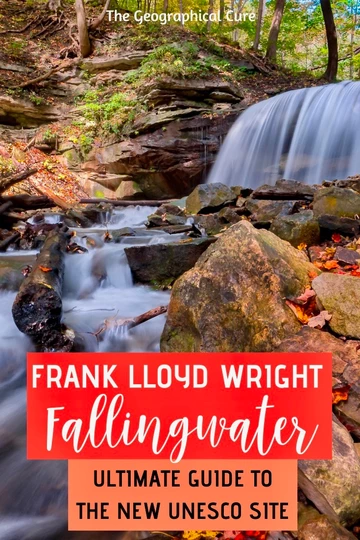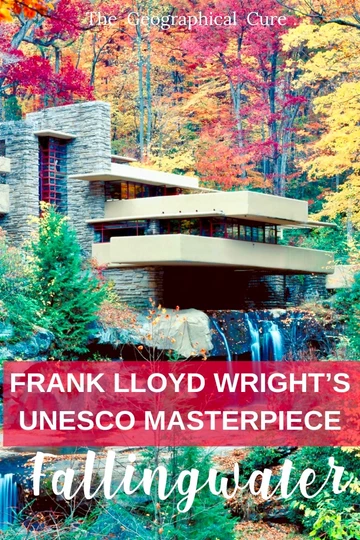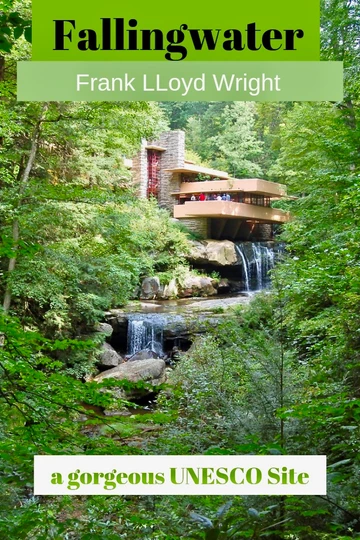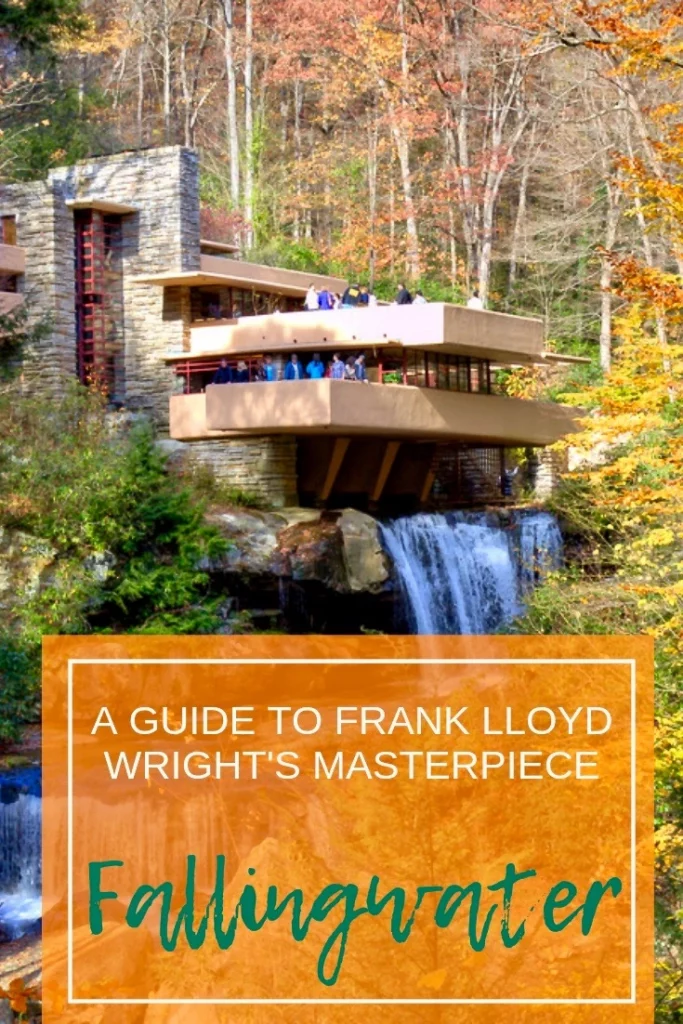“No house should ever be on a hill or on anything. It should be of the hill. Belonging to it. Hill and house should live together each the happier for it.” — Frank Lloyd Wright
Here’s my complete guide to visiting Fallingwater, a new Frank Lloyd Wright UNESCO site in Pennsylvania. Fallingwater is nestled in a bucolic setting, atop a cascading waterfall It’s the apotheosis of Wright’s long lasting obsession with nature and a must see architectural site in the US.
Fallingwater is likely the most significant building of the 20th century. Ask most people to name an American architect, and Wright’s the name you’ll get. And I give you an overview of the life of this architectural visionary.
On July 7, 2019, the UNESCO World Heritage Committee officially inscribed The 20th Century Architecture of Frank Lloyd Wright, to its UNESCO World Heritage List. The designation includes Fallingwater and seven other Frank Lloyd Wright sites.
With a spanking new UNESCO site not far from my home in Pittsburgh, I booked a ticket online and jumped in the car.
Iconoclast Frank LLoyd Wright didn’t come quietly to the architectural world. He conquered it almost overnight.
Within a decade of practice, he had transformed American residential design. Over a 70 year career, he became our most treasured architect. Wright never retired; he called it a “murderous custom.” He led a long and colorful life, dying at age 91 in 1959.
A Short Biography of Frank LLoyd Wright
To understand the architecture, you have to understand the artist. I give you an overview of Wright’s life, career, and the Fallingwater commission.
1. Early Life
Wright was born in on June 8, 1867 in Richland Center Wisconsin of Welsh stock. He was the product of an overbearing mother, Anna LLoyd-Jones, who determined from the cradle that he’d be an architect. She decorated his nursery with prints of Gothic cathedrals.
His father William was no better a parent. He was a charming and proselytizing minister and musician who was disastrous with financial matters, a habit that Wright would inherit. William abandoned the family in 1884, another habit that Wright would inherit.
In 1886, Wright enrolled in the University of Wisconsin, Madison to study civil engineering. He lasted less than two years. Bored, Wright dropped out in 1887 and moved to Chicago. He became a draftsman, eventually landing at a prominent Chicago architectural firm, Adler & Sullivan.
In 1889, Wright married Catherine (“Kitty”) Tobin. In 1893,Wright was fired from Adler & Sullivan for moonlighting. He launched his private practice with 25 designs under his belt.
He built their family home in the Chicago suburb of Oak Park with borrowed funds. The Wrights became notorious for running up bills that they either wouldn’t, or couldn’t, pay. Like his father, Wright tried to survive on charm.
Wright received instant attention and success in his 20s and 30s for his original architecture and radical innovations. He was a prominent Chicago figure by 1900.
2. Invention of the Prairie House
Wright’s fame was kickstarted by a magazine article that announced the invention of the “prairie house.” It was hailed as a new form of family living, a “functional and aesthetic breakthrough.”
Wright grandiloquently dubbed his new aesthetic “Organic Architecture.” By this, Wright meant that his buildings adhered not to the laws of man, but to the laws of nature. The ideal building used indigenous materials and was tied to the native landscape. Wright proclaimed, “I believe in God, only I spell it Nature.”
His prairie homes from 1900 to the 1920s were distinctive. They “hugged the earth” and featured low lying horizontal planes, walls of glass (called “light screens”), cantilevered roofs and terraces, and free flowing interior spaces.
The prairie house had a heightened sense of space and light. Wright essentially wanted to abolish the cookie cutter “box” and replace it with an open “transcendental” design.
3. Wright’s Rocky Mid Life Crisis
I hate to tell you this folks, but, like many artists, Frank Lloyd Wright had a dark side. I’ve written about him at length here. Clad in a wide brimmed hat and red-lined cape, he was premeditatedly flamboyant and an unlikeable character. He had a narcissistic temperament and a massive ego.
Wright was an architectural wunderkind, but a rather wretched person. Architect Philip Johnson once complained that Wright thought he was “born full-blown from the head of Zeus.” I have a special allergy to this type of fabulist.
In 1907, tiring of domestic life, Wright began a torrid affair with a client’s wife, Mamah Borthwick Cheney (pronounced “May-mah”). Mamah was a highly educated intellectual, fluent in several languages, and a feminist — an appealing trifecta for Wright who seemed to need a challenging woman by his side. Mamah, in turn, became obsessed with a vibrant man who was reinventing architecture.
In 1909, Wright claimed that his conventional life situation in Oak Park was “discordant” and that his wife Kitty was a dreadful “bore.” One biographer speculates that he was having a nervous breakdown. At a minimum, it was a serious mid-life crisis.
At the height of success at age 42, Wright left it all behind. He abandoned Kitty, six children, and a thriving Chicago architectural practice. He fled to Europe with Mamah, tabloid style.
Wright later claimed that open adultery was somehow more “honest and true” than a clandestine affair. He thought his children were better off abandoned, so they could find their authentic path in life without his influence. In any event, Wright called his buildings his “real children.”
It all sounds very Ayn Rand-ish, to me — converting caddish behavior into a metaphysical ideal, to justify’s one’s selfish life choices.
In fact, Rand’s bestseller, the Fountainhead, was inspired by Wright’s florid 1932 autobiography. (An autobiography that was roundly criticized as full of “prodigious lies” and self mythologizing.) Rand’s protagonist Howard Roark is based on Wright, although Wright refused Rand’s requests for an interview.
4. Taliesin: Cursed Love Nest and Architecture School
In 1911, after almost two years abroad, Wright returned from Europe with Mamah. He began to build a new home, called Taliesin (“shining brow” in Welsh), in Spring Green Wisconsin. It was his love nest, his “hope and haven,” and a refuge from romantic scandal. Now it’s also a UNESCO site.
Unfortunately, the locals ostracized the pair. They didn’t approve of Wright’s open adultery. Tongues clicked and fingers wagged. Wright was peeved. He tried to justify his actions, saying “It is infinitely more difficult to live without rules. But that is what the really honest, sincere thinking man is compelled to do.”
Taliesin, like Wright, has its own sordid tale of woe, one which involves murder and mayhem. It’s a topic for another blog post. Suffice it to say, domestic bliss was short-lived. In 1914, Mamah and six others were murdered by a deranged ex-servant and Taliesin burned to the ground.
Wright was devastated, lamenting the loss after his five year “struggle for freedom.” And perhaps something in him died with Mamah. Wright set about rebuilding Taliesin, more elaborately than ever, to “wipe the scar from the hill.”
5. Love Life Detours
But Wright didn’t stay single long. He took up with a wealthy divorcee, Miriam Noel, after she sent steamy sympathy letters to him.
The artistic and cleverly styled Miriam was a wild departure from Wright’s first wife Kitty. Miriam was a fantasist and a clairvoyant. She called Wright the “Lord of my waking dreams.” After they married in 1923, Wright discovered she was also a morphine addict.
The marriage was short, brutal, and tumultuous. They separated after five months and agonizing divorce proceedings commenced. Miriam tormented and stalked Wright for years afterward.
Wife #3 was Olga Ivanova Lazovich, a dancer 30 years Wright’s junior. She moved into Taliesin in 1925 and they married in 1928. They got on famously, but had no money. Wright was a chronic spendthrift, perennially indifferent to money, and always lived above his means.
In 1932, Wright incorporated himself and launched a school of architecture at Taliesin, called the Taliesin Fellowship Foundation, to help pay the bills. 30 apprentices would pay tuition and follow Wright’s holistic daily routine. They not only took classes; they farmed Wright’s land for free. Wright called them “the fingers of my hand.”
It was here that Wright met Edgar Kaufman Jr., the son of Edgar and Liliane Kaufman.
6. The History of the Fallingwater Commission
Edgar Kaufman was the patriarch of a prominent Pittsburgh family. He owned an upscale department store downtown. He was nicknamed the “merchant prince.”
Kaufman’s son, Edgar Jr., had read Wright’s autobiography and was inspired. He went to study at Taliesin from 1933-34. In 1935, when his parents decided to build a weekend retreat away from Pittsburgh, he introduced them to Wright.
Wright didn’t build homes for just anybody, of course. No, he interviewed his clients to see if they were worthy of living in a Frank Lloyd Wright original design. The Kaufmans passed the test.
They commissioned Wright to build a summer home in Bear Run Pennsylvania. The family had long loved the verdant natural setting and surrounding waterfalls. Wright agreed to do what he loved best — build a house that celebrated the landscape.
Legend holds that, after procrastinating for nine months, he drew Fallingwater’s design in two hours. The idea of the three floor cantilever from a central core was inspired by pine branches. Wright’s design pushed the envelope, to say the least.
Not surprisingly, there were conflicts between Wright, the Kaufmans and the engineers on the project. The engineers were skeptical of the stability of Wright’s high risk design. They thought more steel was needed to support the poured concrete cantilevers. Wright insisted that architecture was “art” and “to hell” with the engineers’ advice.
Clients must have loathed Wright’s single minded taste for aesthetic purity over practicality. But Wright had a seductive ability to sweep others up in his vision. He also became adept at duping clients into paying more than they wanted.
The Kaufmans budgeted $20-30,000 for the Fallingwater project. It ended up costing $155,000, which converts to $2.7 million today. When queried about budget overruns, Wright cajolingly responded that, with a “few more thousand,” you’ll get what you “need.”
7. Fallingwater Revivifies Wright’s Career
The commission was a boon for Wright. Wright had fallen into obscurity in the preceding decades. This was due to a combination of factors: negative publicity from his personal scandals, the depression, and the rise of the international style championed by another egomaniac, Le Corbusier.
In 1938, a splashy Time magazine cover made Fallingwater instantly famous. Fallingwater put Wright back on the “who’s who of architecture” map and ensured his legacy.
After Fallingwater, Wright was prolific. In nine years, he completed more than one third of his total executed work, including the world famous Guggenheim Museum in New York with its time-continuum white spiraling staircase.
In 1955, Kaufman died and his son inherited the estate. In 1963, Edgar Jr. bequeathed Fallingwater to the Western Pennsylvania Conservancy in honor of his parents. In 1964, Fallingwater opened for public tours.
In 1966, Fallingwater was designated a National Historic Landmark. It’s been listed among the Smithsonian’s 28 Places To See Before You Die. In 1991, the American Institute of Architecture, voted Fallingwater the “best all time work of American Architecture” and Wright the “greatest American architect of all time.” In 2000, the AIA named Fallingwater “the Building of the Century.”
Now, Fallingwater is a UNESCO site.
A Tour of Fallingwater, A UNESCO Gem in Pennsylvania
Let’s take a tour of Fallingwater. Here’s what you need to know and see at Fallingwater.
1. Overview
Fallingwater is eye-grabbing and visually stunning. It’s a marriage of modern architecture and a wild landscape that blurs the line between the indoor and outdoor.
The Kaufmans expected their home to have a view of the 30 foot waterfall. Instead, Wright brilliantly sited Fallingwater on top of the waterfall and anchored it to a boulder, so it would emerge “like a plant from the earth.” From any room in the house, the Kaufmans could hear the falling water.
Listening to the sound of the crashing waterfall as you tour the house is an immersive, almost surreal experience. You can’t help but be enchanted and lulled into a relaxed state of mind. The experience was honestly better than I anticipated.
Fallingwater is 5330 square feet. Half of that footage is allotted to seven stacked concrete terraces, which jut out dramatically from the house’s core. The terraces are ochre colored, corresponding to the color of spent rhododendron leaves.
2. The First Floor
The interior feels like a forest, or possibly a treehouse. You begin on the first floor. It has an open floor plan that combines a living room, dining area, and kitchen. Walls of windows lead to broad decks.
The ceilings are low to put the emphasis on coziness and direct your gaze back to nature via the copious ribbon windows. But the ceiling levels change to give you the sensation that there are separate rooms. In the center, is a recessed skylight framed with beautiful woodwork.
The floors here and throughout the house are made of large slabs of local Pottsville sandstone. They’re polished to shine like the stones in the creek below.
There’s a fireplace, with a chimney that’s the highest point on the house’s exterior. The fireplace surround consists of boulder that was left intact to form the hearth. There’s a built in kettle, in Wright’s signature color Cherokee Red, that can swing over the fireplace to heat up liquids.
Unlike modern kitchens, the dining area and kitchen are surprisingly small and utilitarian. You can’t go in the kitchen, but you have a cordoned off glimpse. The Kaufmans likely didn’t care much about the kitchen, since they had a chef on site.
Wright designed virtually all of the Fallingwater furniture. He was “relentlessly dictatorial” about including furniture in his own design.
Much of the seating is built in. Wright called this style “client proof,” which meant that the clients couldn’t tinker with his decor or rearrange it. The furniture has simple clean lines, reflecting a Japanese aesthetic.
My favorite feature was the “hatch.” It consists of a sliding glass panel that opens to a staircase leading down to the stream below. It visually connects the living room to nature, echoing the flow of water over the falls.
You can’t descend the stairs, but you take a gander and admire the ingenuity of the design. The Kaufmans were initially skeptical about the feasibility and operability of the hatch. But, for Wright, it was a non-negotiable feature of the house.
There’s no air conditioning in the house. I imagined how refreshing it must have been for the Kaufmans to walks down the steps and dangle their feet in the water to cool off.
3. The Second and Third Floors
The second floor consists of the master bedroom, a dressing room/den for Mr. Kaufman, and a guest bedroom. There’s a Picasso in the master bedroom and a Diego Rivera painting in the guest bedroom.
The dressing room features outward swinging “cornerless” windows. The windows help break the “box” of the house and open it up to nature. The room’s woodwork is built directly into the stone walls. Wright was preoccupied with even the smallest of details.
Elongated terraces are daringly cantilevered off both bedrooms. The terraces are one of the most stunning features of the house. They’re supported by steel reinforced concrete.
The bathrooms are surprisingly modern. They don’t really look dated by today’s standards. But the toilets are only 10.5 inches high, another Wright eccentricity. The bathrooms walls and floors are tiled with cork, a soft warm material.
I took note of this feature. We’re currently embarking on a kitchen renovation in our arts and crafts (but not “prairie” style) home. Our architect, Jerry Morosco, a Taliesin student himself, recommended cork for the kitchen floor. Now I know why.
Fallingwater’s hallways are purposefully narrow. Wright wanted them to funnel you into the next room, which would then feel comparatively large. He liked to “compress and expand” a space. I think this tactic was, in part, psychological revenge against tall people.
The third floor was the warren of the Kaufmans’ son. It consists of a stairwell library, small den, which Edgar Jr. used as a drafting studio, and bedroom. The den also features the cornerless windows.
4. The Guest House
In 1940, the Kaufmans commissioned Wright to design a guest house to complement the existing structure.
A covered tiered passageway gently takes you from the main house to the guest house. En route, you’ll see a massive Buddha statue from 750 just casually nestled against a wall. And another Diego Rivera painting.
The guest house consists of a small living room, one bedroom, and a bathroom. Two twin beds are pushed together to form a queen bed, as was the fashion in those days. Apparently, guests never brought their children, who were conveniently “left home with the nanny.”
The guest house boasts an odd swimming pool. Liliane Wright had requested a lap pool. But Wright apparently wasn’t keen on a pool.
They compromised on something that today would be called a plunge pool. The pool is fed by a mountain stream. The temperature never exceeds a very brisk 55 degrees.
5. The Carport
Wright was the Marie Kondo of his time. He didn’t believe in “debilitating” clutter and basically only permitted things that “sparked joy.” In his world, garages, storages rooms, and garages were banished. He told his clients to throw their stuff away.
So the Kaufmans didn’t have a garage. (Or a basement.) Instead, Wright invented and coined the term “carport.” The trellises outside the carport are now covered with — oh the horror — non-native wisteria vines that must be constantly pruned back.
6. Preservation & Rescue of Fallingwater
Like many of Wright’s buildings, Fallingwater has required major intervention and preservation.
The frequent leaks, sags, and flaws of his buildings didn’t matter much to Wright. He thought they were the price you paid for the perfection of a cutting edge design. Buildings, like their architects, couldn’t escape “the mortgage of time.”
Wright also didn’t believe in “unnatural” devices in his homes, like window screens or blinds. But the Kaufmans themselves eventually had to install screens. It wasn’t just mosquitos they feared. They had a bat problem.
In 1980, Fallingwater’s windows were replaced. Originally, they were single paned and the glass provided the perfect optics. But to conserve the art collection, double paned windows with ultraviolet protection were installed.
In 2002, a major disaster loomed. The living room’s cantilever, on which the second floor terrace rests, was drooping due to gravity. Over time, it had dropped almost 7 inches from its original position. Turns out, the skeptical engineers were right about flaws in Wright’s original design.
Fallingwater was a folly in danger of falling down. The sagging masterpiece needed a boost.
It took two years to raise the $11.5 million needed for structural modifications. A post-tensioning cable system was employed, where high strength steel cables were first anchored into the concrete skeleton beneath the house and then tightened. Fallingwater’s terraces are now monitored on a semi-annual basis.
Practical Information & Tips for Visiting Fallingwater
Fallingwater is located in rural Pennsylvania, about 1.5 hours from Pittsburgh. Be forewarned, our GPS took us down a bumpy gravel road enroute. You can only visit by purchasing tickets in advance and visiting on a guided tour.
When you arrive, you give your name to the parking attendant, who will confirm your reservation. That person will let you through the gate. Park and walk up to the Visitors’ Center. You need to check in at the Information Desk in the center.
You’ll be given a number for your tour, which will last approximately one hour. Wait for your tour number to be called. If you’re early, there’s a museum cafe and a delightful museum shop at the visitors’ center.
As the website will tell you, you can’t take photos of the interior on the general tour for $30. You can only take photos on the more expensive tour at 8:00 and 8:45 am that costs $80. I must admit this price discrimination irked me, and I cheated just a little.
Many museums ban photos to enhance the museum experience or to ward off flash photography. Others don’t, of course. But to make photography dependent on relative wealth seemed wrong to me. Either ban it universally or allow it universally.
No drones or aerial photography are allowed on the grounds either.
One other thing for your mental checklist. The site is extremely strict about the size of your bag. Understandably, they don’t want you to accidentally bump into a priceless Tiffany vase or lamp accidentally.
No backpacks, large handbags, or tripods are permitted. I had a medium size handbag, but it ever so slightly exceeded the maximum 10 x 10 x 3 size, which I only learned about upon arrival.
So bring a small handbag or leave your bag in the car. I had to schlep mine back to my car. There are also lockers on the premises to store your things.
When the tour is over, head to the “Viewing Point” for your Instagram photos. A trail leads you to a bird’s eye view of the house across from Bear Run. This is the iconic shot you’re accustomed to seeing in photos of Fallingwater.
You can’t help but fall for Fallingwater. It’s a primal physical and spiritual experience. A staggeringly beautiful and reckless architectural jewel, perfectly at ease with its rhododendron dappled landscape.
It’s easy to enjoy. All you have to do is listen to “the music of the stream.”
Address: 1491 Mill Run Road, Mill Run, PA 15464
Hours: Tours run from March 9 through December 31, except Wednesdays
Entry Fee/Tickets: Tickets may be purchased in advance online or by calling Visitor Services at 724-329-8501.
Website
You may enjoy these other United States travel guides and resources:
• 25 most beautiful towns in New England
• 45 amazing destinations in the United States • 10 day itinerary for New Hampshire
• 10 day itinerary for coastal Maine
• 7-10 day itinerary for Vermont
• Fall foliage road trip in New England
• 2 week itinerary for the American Southwest
• 10 day itinerary for southern California
• 2 day itinerary for Philadelphia
If you’d like to visit Fallingwater, pin it for later.

